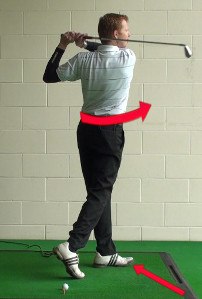
Far too many amateur golfers finish the swing with their entire body facing the target, the left (lead) foot swinging wildly around as they watch the ball fly away. (Or roll away, as the case may be.)
This is usually caused by a reverse-pivot, with the weight shifting toward the target on the backswing, then away from it on the through-swing – the exact opposite of the proper action.
The reverse pivot is the No. 1 cause of slicing, so the swinging-left-foot is more than an aesthetic issue. If you tend to finish this way, one great cure is to step through with your right foot as you contact the ball.
Why is it OK to swing the right foot around? Because to do so, your weight must be moving toward the target, rather than away from it. Transferring weight from right to left is an absolute swing essential.
Nine-time major winner Gary Player popularized the so-called step-through swing, and it's quite simple. 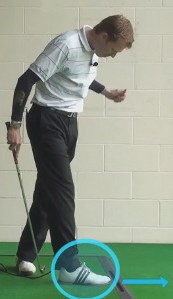 Try it in practice, and don't be afraid to take it to the course:
Try it in practice, and don't be afraid to take it to the course:
- Make your normal swing, but as the club approaches and contacts the ball, step toward the target with your right foot only.
- Pivot around your left foot, which remains in its original spot, and finish with your whole body facing the target. You may even keep walking right through the shot.
If you improperly shift your weight to the left on the backswing, you'll find this drill next to impossible. Practice a proper turn and weight transfer until the step-through becomes natural.
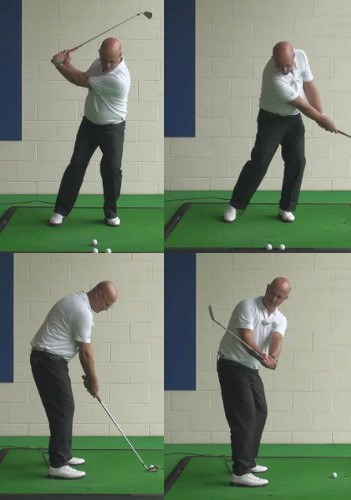
Cause and Drill Cure for a Reverse Pivot
The reverse pivot is one of the biggest problems in all of golf – and many players don't even know what it is. If you have a reverse pivot in your golf swing, you are going to be prone to all kinds of various problems on the course, including slicing the golf ball and hitting short shots. Although the reverse pivot is actually a relatively simple problem to understand once you know what it is, it can be extremely difficult to fix. Some players never manage to get out of the habit of using a reverse pivot, and those players are likely to struggle with inconsistent play and a weak shot pattern throughout their golfing careers.
Of course, before you can address the possibility of a reverse pivot in your game, you have to know what one is in the first place. In a reverse pivot swing, the movement of the weight of your body will be opposite to what it would be in a proper golf swing. When you are swinging the club correctly, your weight will remain nicely balanced as you swing back, with perhaps just a slight move to the right (for a right handed golfer). Then, on the way down, the weight moves left along with the club as you put everything you have into the shot. Executed correctly, this is how powerful shots are created – balance on the way back, and a rotational move to the left in the downswing to strike the ball.
With a reverse pivot, however, this equation goes all wrong. During the backswing, weight moves to the left, placing a majority of your weight on your left foot and in front of the golf ball. Then, on the way down, there needs to be a correction to make sure you are able to hit the ball at all, so your weight moves back right and away from the target. While this move will enable you to at least make contact with the ball, it will rob you of nearly all potential power at the same time. The strike will be weak when a reverse pivot has been used, and it will often lead to a slice as well. Players with a reverse pivot also tend to come into impact rather steeply, meaning they will take a big divot and will always run the risk of hitting their shots fat. In other words, there isn't much positive to say about the reverse pivot.
To fix this problem, it is necessary to first understand why it is happening. Once that step is out of the way, you can then work on determining a course of action to correct your technique appropriately. In the content below, we are going to work on understand why the reverse pivot makes its way into the swings of so many golfers, and then we will outline a drill that can help remove it once and for all. You simply aren't going to reach your goals on the course while the reverse pivot is still in your swing, so make today the day you set out to eliminate it for good.
All of the content below is based on a right handed golfer. If you happen to play left handed, please take a moment to reverse the directions as necessary.
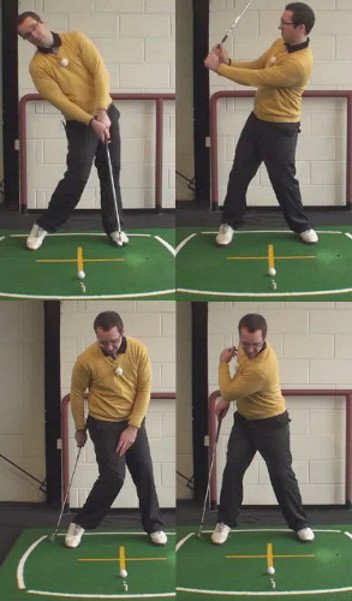
Causes of a Reverse Pivot
When something goes wrong in your golf swing, the natural inclination is to try to fix the problem as quickly as possible. While there is nothing really wrong with that approach, it is important to take some time to think about why the problem has popped up in the first place. If you never think about the why, you will always find yourself returning to the same issues time and again. Rather than continually having to fix the same old swing mistakes, take some time to figure out why you are making these mistakes and it will be much easier to avoid them in the future.
In the case of the reverse pivot, there are a few potential causes that could be leading you down this troublesome path. If you aren't sure exactly why you have started to use the reverse pivot in your own swing, check out the list below. Most likely, the underlying cause of your swing problem is going to be found in one of the following points.
- Forcing a long backswing. By far, this is the most-common reason to wind up with a reverse pivot. The issue is actually quite simple – as you swing the club back, you may start out with quality balance over the ball. However, as you try to swing further and further back, your weight will be forced to the left to compensate for the movement of the club. You should only swing back as far as you can without losing your balance, and no farther. Unless you are highly flexible, that means you will need to make a compact swing and then start to move forward aggressively. Players who are determined to make a long swing – even if they aren't very flexible – are sure to wind up with a reverse pivot. Without balance at the top, that long swing isn't going to do anything for you in terms of power, so it will all be a waste in the end. Keep your backswing tight, stay on balance, and prepare yourself to move left in the downswing.
- Lack of knee flex. If you stand over the ball with your legs in a straight position, you will have trouble holding your balance properly throughout the swing – making the reverse pivot a real possibility. Knee flex is one of the keys to making a quality swing, yet many amateur golfers miss on this point when setting up to hit a shot. Make sure your set yourself deep into your stance with plenty of knee flex and it will instantly become easier to hold your balance throughout the backswing and downswing. In addition to helping you stay away from a reverse pivot, flexing your knees sufficiently will help in a number of other ways as well.
- Steep backswing. This cause is not as common as the first two, but it is certainly another way in which a reverse pivot can be created. If you start out your backswing on a steep path by elevating the club head too quickly off the ground, you may force yourself to lean left. Usually, this kind of mistake is caused by hands that are too active early in the swing. When you hinge your wrists early on in the takeaway, the club will get up into the air and a steep path will be established. To correct this problem and potentially put yourself back on balance, work on taking your hand action out of the swing in the early stages. Complete the takeaway with your shoulders rather than your hands and wrists, and you will be in great shape.
It is more important than you might think to unravel exactly what it is that is causing your reverse pivot. Too many golfers just go from one fix to another without ever really stopping to think about the problems that are hiding underneath – and in the end, those golfers never really gain ownership over their swings. Instead, work hard to figure out why you are doing what you are doing, and you will be a better golfer over the long run.
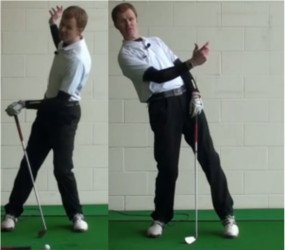
Looking for Proof
In golf, you never want to try fixing problems that don't exist in the first place. That might sound like an obvious point, but it is a mistake that is made by countless players of all skill levels. If you just assume that you are making a certain mistake, you might find yourself trying to solve the issue when it doesn't actually exist in the first place. In this case, you need to confirm that you are actually using a reverse pivot in your swing before you take steps to correct the problem.
Since you can't see your swing while you are making it – unless you take the time to record a video, which isn't a bad idea – you will need to look for 'evidence' that points to a reverse pivot. Some of the telltale signs are listed below –
- Deep divot from outside-in. Your divot pattern can tell you a lot about your golf swing, so it is wise to pay attention to the turf you are carving out of the ground after each swing. In this case, you should be watching for a pattern that cuts across the ball from outside-in while going deep down into the ground. A deep divot alone is not necessarily a guarantee of a reverse pivot, but combining depth with an outside-in shape is a bad sign. A good divot is one that is relatively shallow and pointed right down your target line, so anything that deviates dramatically from that pattern is cause for concern.
- High slice. This is a ball flight pattern that frequently accompanies the divot pattern in the point above. If you are regularly hitting high slices with a number of your clubs, you could be using a reverse pivot in your swing. The steep, outside-in swing path that creates the divot described above is the same swing path that can very likely create a high slice. Obviously you are never going to be able to play productive golf when you hit a high slice, so you should be working on correctly this issue as quickly as possible.
- Finishing on your right foot. This is perhaps the most conclusive piece of evidence when looking for a reverse pivot. As a right handed golfer, you should be finishing your swing with the majority of your weight stacked up on your left foot. If, however, you are winding up leaning back on your right foot as you watch the ball fly, it is nearly certain that you are making a reverse pivot to at least some degree. This is going to be a case of fixing the root problem in order to get your weight in the right spot during the finish. By going back to work on removing the reverse pivot from your swing, you should find that your weight quickly makes its way onto the front foot as you get your overall swing shape sorted out.
While you want to get your swing sorted out as quickly as possible, you also don't want to rush to a conclusion as to the current status of your technique. If you think you are using a reverse pivot, carefully consider all of the evidence at hand before deciding how to proceed. Of course, if you still aren't sure after looking for the points above, you can also ask a friend to record a video of your swing in order to uncover the truth once and for all. The video recording of your swing won't lie, so you can determine what is going on in your swing with confidence before taking the appropriate next steps.

Reverse Pivot Drill
As promised in the title of this article, we are now going to get into a drill that can help you eliminate your frustrating reverse pivot once and for all (assuming that you are, in fact, making this mistake in your game). Using a drill is a great way to teach yourself the proper way to swing the club. It is one thing to read about the mistakes you need to avoid, but it is another thing entirely to take a drill with you out to the driving range for your next practice session. There won't be any improvements made without practice, and the drill outlined below will help you get the most from the practice time you do invest.
To get down to the business of removing the reverse pivot from your swing, follow the step-by-step directions below during your next visit to the range.
- To get started with this drill, find yourself a space to make some swings on the range. You aren't going to be hitting shots right away, so you don't even need to have a bucket of range balls nearby at this point – just find a space to swing while focused on improving your technique.
- For these initial swings, take your seven iron from the bag. A seven iron is a club that is long enough to pull you into a full swing (which you can't necessarily say for a wedge), but is short enough to make it easier to control than a driver or three wood.
- With your seven iron in hand, take your stance and get ready to make a swing. You don't necessarily need to pick a target for these practice swings (since you won't be hitting a ball), but you should pay attention to your address position to make sure your body is in the right spots. Only when you have carefully built your stance should you feel free to move on to the next step.
- As you are standing over this (imaginary) shot getting ready to swing, you are going to make one quick adjustment before putting the club in motion. As address, lift up the heel of your left foot so that only the toe of your shoe is on the ground. Naturally, as you make this adjustment, some of your weight is going to move to the right, and that is okay.
- Your address position is now altered, obviously, and it is time to start the swing. As you swing back, you should focus on keeping a slight majority of your weight on your right foot rather than your left. Since your left heel is off the ground, you will hopefully find it difficult (or even impossible) to make a reverse pivot as you have been doing in your normal swing. Your left foot won't be able to handle a majority of your weight since only the toe is on the ground, so you will be forced to keep your weight on the right side.
- Once you get to the top of the swing, it is time to return the left heel to the ground so you can initiate the downswing properly. As the club transitions from backswing to downswing, move the heel into the ground and swing through to a full finish. The action of moving your heel down toward the ground should help your weight to get moving left, and you will likely find it easy to swing up onto your left leg as you complete the action. Hopefully, in the end, you will wind up with your weight totally over your left foot in a comfortable, balanced position. Also, you should have your right heel up off the ground in the finish, with only the toe of your right shoe remaining on the turf.
This drill is simple to be sure, but it is also highly effective. By making just that one basic adjustment of taking your heel off of the turf at address, you are going to completely change the way your weight is allowed to move during the swing. The reverse pivot will be nearly impossible to accomplish, so you will have to swing in a manner that has your weight in a better position from start to finish.

Moving Forward from the Drill
Once you get the hang of this drill, you can certainly feel free to use it as often as you like. In fact, in addition to doing the drill on the driving range, you can even use it as a practice swing drill on the course prior to hitting your shots. However, while the drill is a great way to break the habit of using a reverse pivot, you do need to be careful of a couple things if you are going to get the best possible results from your effort. Check out the points below and keep these in mind while working on refining your technique.
- Don't get too far right. You certainly want to stay off of your left side while making your backswing, but you don't want to drift too far right, either. Ideally, you will be able to stay nicely balanced in the middle of your two feet while swinging back and up to the top of your swing. Remember, drills often exaggerate the feelings you need to have in order to drive home a point, and that is true in this case. While doing the drill, your weight is going to be farther on your right side than it will be when you make a regular swing. Once your left foot is down on the ground and you go back to making normal swings, be sure to stay as balanced as possible throughout the entire backswing.
- Rotate left rather than sliding. The move that you make to your left in the downswing needs to be mostly a rotation rather than a slide. It is the turning action that you make to the left that will allow you to develop speed and power in your swing. If you slide left rather than rotating with your lower body, you will lack power through the hitting area and you will very likely hit from the outside. Whether doing the drill or making a regular swing, be sure to turn hard left with your lower body on your way through the shot.
It is nearly impossible to play good golf when you have a reverse pivot in your game. Take time to work through the necessary corrections and use the drill provided above to get this part of your swing corrected once and for all. With better balance in place, you should have no trouble adding both accuracy and distance to your shots in the near future. The transition from reverse pivot to a swing with better balance is going to be challenging at first, but it will be worth it in the end when you start striking the best shots of your life.






